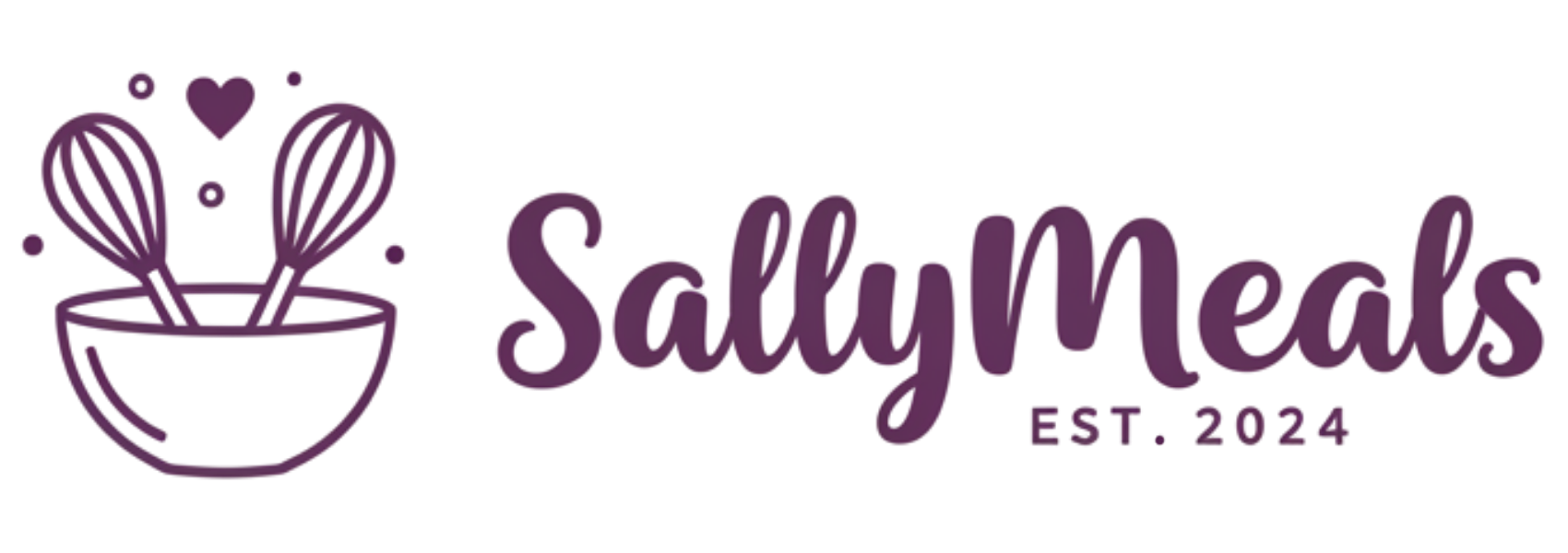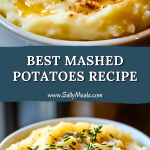There’s something so deeply comforting about a bowl of creamy, buttery mashed potatoes that just makes any meal feel complete. I’ve been perfecting this recipe over the years, and I truly believe it’s the best mashed potatoes recipe you’ll ever try. With the right balance of rich dairy, fluffy texture, and just enough seasoning to make the potatoes shine, this dish is always a hit — especially at gatherings like a cozy Halloween party or a hearty family dinner.
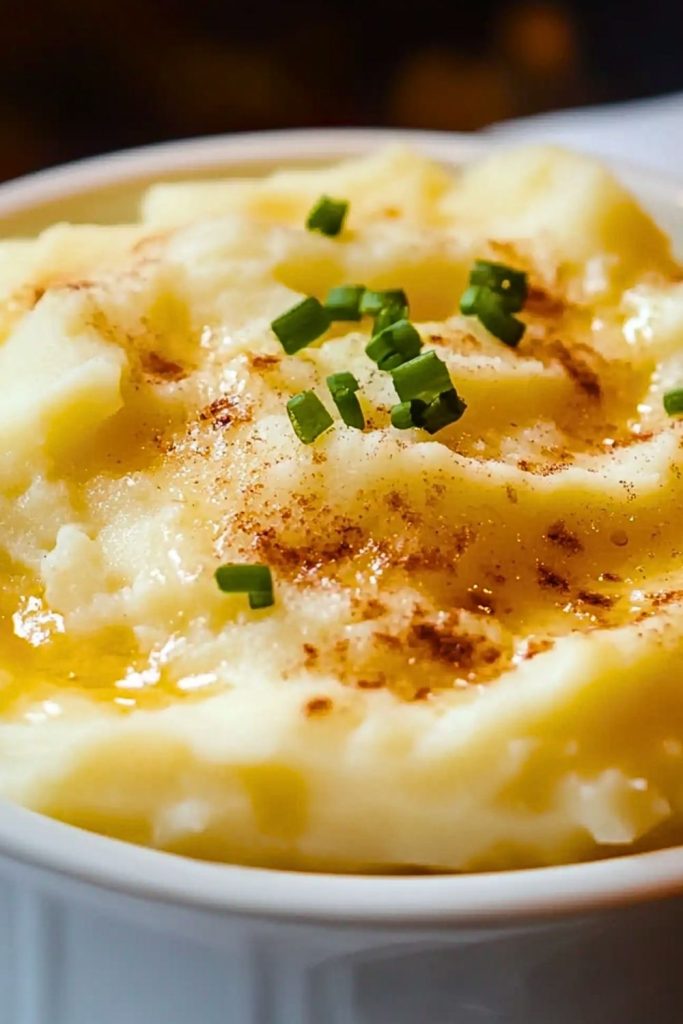
I love how versatile mashed potatoes are. Whether you serve them as a side for a roast, layer them into a shepherd’s pie, or simply enjoy them with some gravy, they always deliver that warm, nostalgic satisfaction. This recipe isn’t fussy — no complicated steps or rare ingredients — just real food done really well.
Why You’ll Love This Best Mashed Potatoes Recipe
- Ultra Creamy Texture: Thanks to the perfect combo of butter and cream.
- Big on Flavor: Garlic, salt, and just the right amount of pepper elevate the potatoes.
- Perfect for Holidays: Always a crowd-pleaser on any dinner table.
- Easy to Make Ahead: Reheats like a dream without losing its creaminess.
- Customizable: Add cheese, herbs, or even bacon for your own twist.
What Kind of Potatoes Are Best for Mashed Potatoes?
For the fluffiest, creamiest mashed potatoes, I always reach for Yukon Gold or Russet potatoes. Yukon Golds have a naturally buttery flavor and creamy texture that makes them perfect for mashing without needing tons of extra ingredients. Russets, on the other hand, have a high starch content, which gives you that classic, light and fluffy mash. You can even mix the two for a dreamy balance of flavor and texture.
Avoid waxy potatoes like red or new potatoes. They don’t break down as well when cooked and can turn gluey when mashed — not what we’re going for here!
Options for Substitutions
If you’re missing an ingredient or just want to change things up a bit, here are some easy swaps that still keep the dish delicious:
- Butter → Try olive oil or ghee for a dairy-free or nutty twist.
- Heavy Cream → Use whole milk, sour cream, or Greek yogurt for a lighter or tangier flavor.
- Garlic → Roasted garlic adds a deep, mellow flavor. Garlic powder works in a pinch.
- Chives → Swap with green onions, parsley, or skip them for a more classic taste.
- Salted Butter → If using unsalted butter, just add a pinch more salt to balance.
- Vegan Option → Use plant-based butter and oat or almond milk — just warm it before adding so it blends well.
These simple swaps can help you tailor the recipe to your taste or dietary needs without compromising that classic mashed potato comfort.
Ingredients for This Best Mashed Potatoes Recipe
Let’s break down the ingredients that make this mashed potatoes recipe truly stand out. Each one plays a role in bringing that creamy, rich, and comforting flavor to life:
- Yukon Gold Potatoes
Their naturally buttery texture and slightly sweet flavor make them ideal for mashing. They create that velvety consistency we all crave. - Butter
Melted into the hot potatoes, butter adds depth, richness, and that unmistakable luxurious finish. - Heavy Cream
This is what makes the mash so decadent. It enhances creaminess and gives the dish its silky mouthfeel. - Garlic (optional but recommended)
Adds a gentle punch and warmth. Use roasted garlic for a mellow, nutty edge or fresh for a sharper note. - Salt
Essential to bring out all the natural flavors of the potatoes and dairy. Don’t be shy with it — potatoes can soak it up. - Freshly Ground Black Pepper
Just a little adds a subtle heat and balances the richness of the dish. - Chives or Green Onions (for garnish)
A touch of freshness and color right before serving makes your mash feel extra special and finished. - Milk or Sour Cream (optional)
If you prefer a tangy bite or a lighter version, either of these can replace part of the cream.
Each of these ingredients contributes to the harmony of textures and flavors — comfort food, done right.
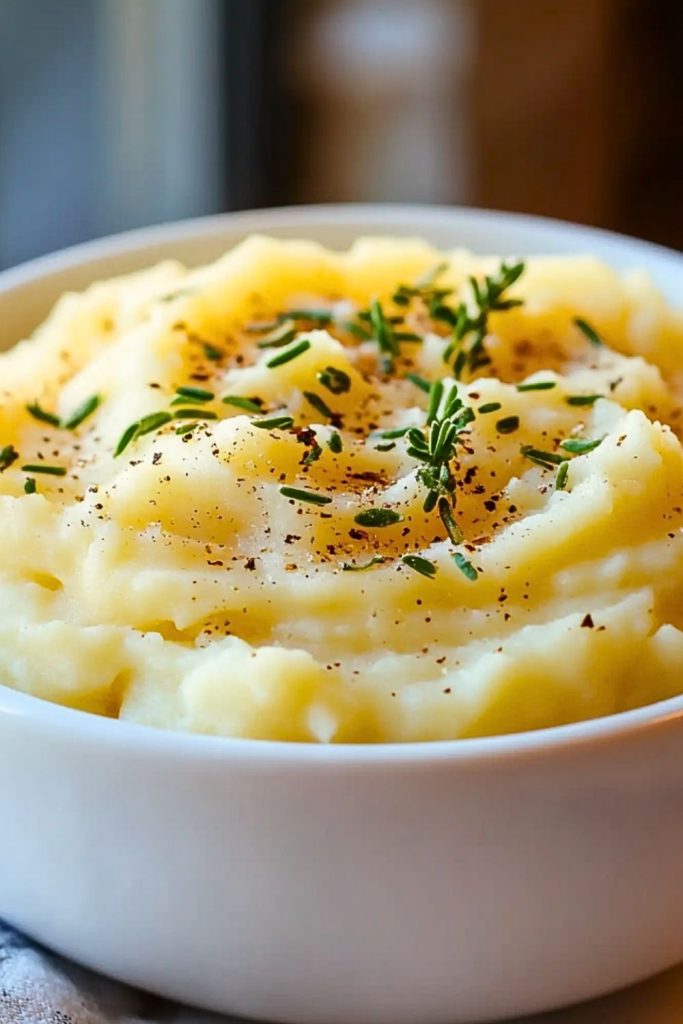
Step 1: Peel and Cut the Potatoes
Start by peeling your Yukon Gold (or Russet) potatoes and cutting them into evenly sized chunks, about 2-inch pieces. This helps them cook evenly and prevents some pieces from becoming mushy while others remain firm.
Step 2: Boil Until Fork-Tender
Place the potato chunks into a large pot and cover them with cold water. Add a generous pinch of salt, then bring to a boil over medium-high heat. Once boiling, reduce to a simmer and cook until the potatoes are fork-tender — usually about 15 to 20 minutes.
Step 3: Drain and Dry the Potatoes
Drain the potatoes thoroughly in a colander. Then, return them to the still-warm pot and let them sit for a couple of minutes. This step allows excess moisture to evaporate, which is key to avoiding watery mashed potatoes.
Step 4: Warm the Cream and Butter
While the potatoes are drying out a bit, warm the heavy cream and butter together in a small saucepan (or microwave-safe bowl). Warm liquids blend better with the potatoes and help keep the mash hot and smooth.
Step 5: Mash to Your Preferred Texture
Using a potato masher or ricer, mash the potatoes until smooth (or leave a few small lumps if that’s your style). Avoid using a blender or food processor — they’ll make your potatoes gummy.
Step 6: Mix in the Good Stuff
Slowly pour the warm butter and cream mixture into the mashed potatoes while stirring gently. Add salt, pepper, and optional garlic to taste. Stir until fully combined and creamy.
Step 7: Garnish and Serve
Transfer your mashed potatoes to a serving dish, top with extra butter, a crack of pepper, and a sprinkle of chives or green onions. Serve hot and watch them disappear.
How Long to Cook the Best Mashed Potatoes
From start to finish, this mashed potatoes recipe takes around 35 to 40 minutes.
- Prep Time: 10 minutes (peeling and chopping)
- Boil Time: 15–20 minutes (until fork-tender)
- Finishing Time: 10 minutes (mashing and mixing)
Potatoes are ready when they’re completely tender and easily pierced with a fork. Undercooked potatoes will leave you with lumps that no amount of mashing can fix — so be patient and check a few pieces before draining.
Tips for Perfect Mashed Potatoes
- Start with Cold Water: Always place potatoes in cold water before boiling. This ensures they cook evenly inside and out.
- Dry Them Well After Boiling: Letting them sit in the pot post-drain removes excess water and prevents soggy mash.
- Warm Your Cream and Butter: Cold dairy will cool your potatoes and make them harder to mix. Warm is the way to go for maximum creaminess.
- Use a Ricer for Smoothness: If you’re going for ultra-smooth potatoes, a potato ricer gives the fluffiest result.
- Don’t Overmix: Overworking the potatoes releases starch and can lead to a gummy, gluey texture. Stir gently and stop when it’s creamy.
- Season Thoughtfully: Taste as you go! Salt and pepper should be adjusted depending on your preferences and the butter used.
- Serve Immediately: Mashed potatoes are best hot and fresh. If you need to keep them warm, a slow cooker on low or a double boiler works wonders.
- Add Extra Flavor: Want to level it up? Mix in some roasted garlic, parmesan, or cream cheese for something a little more indulgent.
Watch Out for These Mistakes While Cooking
Even a classic dish like mashed potatoes can go sideways if you’re not careful. Here are the most common pitfalls to avoid:
- Starting with Hot Water
This causes the outside to cook faster than the inside, leading to uneven texture. Always start with cold water. - Undercooking the Potatoes
If they’re not completely fork-tender, you’ll end up with lumps that just won’t mash out. - Skipping the Drying Step
Wet potatoes = watery mash. Let them steam dry in the pot after draining. - Using Cold Butter and Cream
Cold ingredients shock the potatoes and cause them to seize up, making mixing difficult and reducing creaminess. - Overmixing
This can release too much starch and turn your potatoes gummy. Mash just until smooth. - Using the Wrong Tools
Blenders and food processors break down the starch too much. Stick with a masher or ricer. - Not Salting the Water
Like pasta, potatoes need salt from the start. Season the boiling water generously for flavor from the inside out. - Rushing It
Good mashed potatoes take a little care. Don’t rush the boil or skip steps — each one makes a difference.
What to Serve With Best Mashed Potatoes?
Mashed potatoes are the ultimate sidekick. Whether you’re planning a holiday feast or a quick weeknight dinner, they shine next to all kinds of dishes. Here are some of my go-to pairings:
Herb-Crusted Roast Beef
Tender, juicy roast beef and creamy mashed potatoes are a match made in comfort food heaven.
Garlic Butter Roast Chicken
A juicy roast chicken with crispy skin pairs beautifully with the buttery mash.
Braised Short Ribs
Rich and fall-off-the-bone, short ribs soak into the mash like gravy gold.
Honey Glazed Carrots
The sweet and savory carrots bring balance and color to the plate.
Pan-Seared Salmon
Creamy potatoes contrast beautifully with the crisp crust and buttery richness of salmon.
Roasted Broccoli or Brussels Sprouts
Add some green to the plate with oven-crisp veggies for a complete meal.
Classic Meatloaf
Retro in the best way — meatloaf and mashed potatoes are comfort food royalty.
Mushroom Gravy
Even without meat, mashed potatoes shine under a blanket of earthy, savory mushroom gravy.
Storage Instructions
Mashed potatoes are one of the best leftovers — they reheat well and can even be repurposed into new dishes. Here’s how to store them properly:
- In the Refrigerator
Let your mashed potatoes cool completely, then transfer them to an airtight container. Store in the fridge for up to 4 days. - Freezing
You can freeze mashed potatoes if they’ve been made with plenty of butter and cream — this fat helps preserve texture. Spoon into a freezer-safe container or freezer bag, press out the air, and freeze for up to 1 month. Thaw overnight in the fridge and reheat slowly on the stovetop with a splash of cream or milk. - Reheating Tips
To reheat, use a saucepan over low heat, adding a little cream or milk and stirring gently. Microwave also works well in 1-minute intervals, stirring in between. A slow cooker is a great option for reheating large batches — just stir occasionally and add liquid as needed to keep things creamy.
Estimated Nutrition
Here’s a rough breakdown per serving (based on a standard portion size, about ¾ cup of mashed potatoes):
- Calories: 220
- Total Fat: 11g
- Saturated Fat: 7g
- Cholesterol: 35mg
- Sodium: 310mg
- Carbohydrates: 28g
- Fiber: 2g
- Sugars: 1g
- Protein: 3g
These values will vary depending on how much butter or cream you use (or if you add extras like cheese or bacon). Still, it’s a satisfying side that fits comfortably into a balanced meal.
Frequently Asked Questions
How do I keep mashed potatoes from getting gluey?
Avoid overmixing and never use a blender or food processor. Stick to a masher or potato ricer, and mix gently with warm dairy ingredients.
Can I make mashed potatoes ahead of time?
Absolutely! You can make them a day or two in advance and reheat gently with a splash of cream or milk. A slow cooker on low works wonderfully for keeping them warm for hours.
What if I don’t have heavy cream?
No worries — whole milk, half-and-half, sour cream, or even Greek yogurt will do the job. Just make sure to warm whatever you use before adding it to the potatoes.
Can I add garlic or other flavors?
Definitely! Roasted garlic is a dreamy addition. You can also try adding cream cheese, herbs like rosemary or thyme, or even sharp cheddar for a cheesy twist.
Can I freeze leftover mashed potatoes?
Yes! Just make sure they contain enough butter and cream, which helps maintain texture after freezing. Store in an airtight container and freeze for up to one month.
How many servings does this recipe make?
This recipe yields about 6 generous servings, but you can easily double it for a crowd or halve it for a smaller dinner.
How do I make this recipe vegan?
Use plant-based butter and warm oat, almond, or soy milk instead of cream. Add roasted garlic or nutritional yeast to amp up the flavor.
Why do I need to salt the water when boiling potatoes?
Just like pasta, potatoes absorb flavor while cooking. Salting the water seasons the potatoes from the inside out and brings out their natural taste.
Conclusion
There’s something undeniably comforting about a scoop of perfectly creamy mashed potatoes. It’s more than just a side dish — it’s a nostalgic staple that brings everyone to the table. Whether you’re making it for a holiday meal, a cozy Sunday dinner, or just because you need a little comfort on a weekday night, this recipe delivers every time. With just the right balance of flavor, texture, and ease, these mashed potatoes will quickly become your go-to. Trust me — once you try them, you’ll never go back to boxed again.
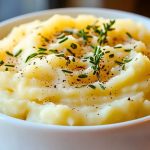
Best Mashed Potatoes Recipe
- Prep Time: 10 minutes
- Cook Time: 20 minutes
- Total Time: 30 minutes
- Yield: 6 servings 1x
Description
Get ready to fall in love with the ultimate comfort food — this Best Mashed Potatoes Recipe delivers everything you crave: creamy texture, buttery flavor, and an irresistible richness that completes any meal. Whether you’re searching for a quick dinner side, holiday dish, or easy recipe for a cozy night in, these mashed potatoes check every box. They’re simple to make, naturally gluten-free, and endlessly customizable. The result? A bowl of pure joy that brings people together, spoonful after spoonful.
Ingredients
- 3 pounds Yukon Gold potatoes, peeled and cut into chunks
- 6 tablespoons butter (plus more for serving)
- 1 cup heavy cream (or whole milk)
- 2 teaspoons salt (plus more for water)
- 1/2 teaspoon freshly ground black pepper
- 2 cloves garlic, minced or roasted (optional)
- Chopped chives or green onions, for garnish
Instructions
- Peel and cut the potatoes into even-sized chunks.
- Place potatoes in a large pot and cover with cold, salted water.
- Bring to a boil, then reduce to a simmer and cook for 15–20 minutes until fork-tender.
- Drain the potatoes thoroughly and return them to the hot pot to dry for 1–2 minutes.
- In a small saucepan, warm the butter and cream together until melted.
- Mash the potatoes using a masher or ricer to your preferred texture.
- Gradually mix in the warm butter-cream mixture, salt, pepper, and garlic (if using).
- Taste and adjust seasoning as needed.
- Transfer to a serving dish, top with extra butter and garnish with chives.
